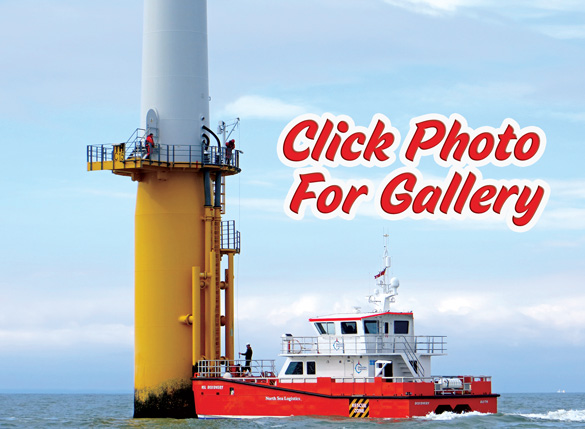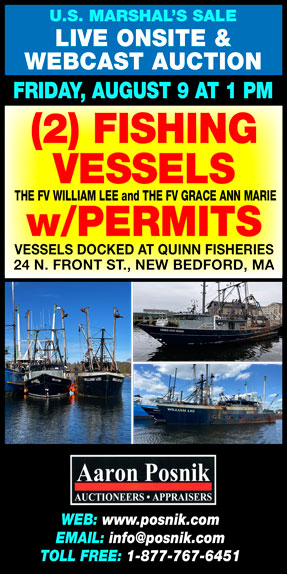(UPDATED) BROADSTAIRS, KENT – Looking out over the English Channel on a quiet night in March, the horizon is surprisingly ablaze with lights. A local fisherman quips, “People ask us if that’s France.”
It’s not. This illusion of a “city” of lights is the result of hundreds of enormous illuminated turbines in a string of wind farms located just off the southeast coast of England.

The 72′ NSL Discovery, seen here transporting workers to a turbine in the Thanet Offshore Wind Farm, helps put the enormous size of these structures into perspective. (Lorelei Stevens photo)
CLICK PHOTO TO VIEW GALLERY
The United Kingdom (UK), which is made up of England, Scotland, Wales, and Northern Ireland, is racing to meet a European Union (EU) goal set in 2009 to generate 20% of the EU’s energy needs from renewable sources by 2020.
Offshore wind energy is a big part of the UK’s strategy for keeping up its end of the bargain, and the speed at which wind farm construction has taken place has suddenly and irrevocably changed the lives of the inshore fishermen who once fished the waters the farms now occupy.
As of early 2013, a total of 25 wind farms, ranging in size from 30 to 216 turbines, were either under construction or operational in UK waters. In a number of areas, the farms are clustered or contiguous, intensifying the impact on fishing operations.
The learning curve for UK fishermen has been huge.
“The government went for a rapid and massive drive into ‘renewable energy’ through wind farms at sea and the fishing industry was left to catch up,” said Tom Watson, a former fisherman who now serves as a fishing industry representative for seven offshore wind farm projects.
Government officials, too, have been scrambling to figure out new siting and leasing procedures, how to rapidly assess environmental impacts, and how best to engage the public in planning processes to ensure that offshore wind farms are sited where they will do the most good – and the least harm.
Northeast US next
Here in the Northeast US, offshore wind energy development is about to take off. Between the Obama Administration and a number of states, the path already has been cleared for the construction of up to 23 wind farm projects between Maine and North Carolina.
And, on April 16, the administration announced adoption of the National Ocean Policy Implementation Plan, which streamlines federal decision-making and permitting processes and formalizes a “Coastal and Marine Spatial Planning Initiative” that some describe as “ocean zoning.” Clearly, industrial development of the waters off our coast is closer to becoming a reality than ever before.
The Ocean Conservancy (TOC), a Washington, DC-based environmental group, has made a commitment to promoting “smart ocean planning.” The goal is to ensure that offshore renewable energy development proceeds in a way that avoids conflict with marine life, the ocean environment, and ocean-dependent industries – including commercial and recreational fisheries – that support millions of jobs and generate billions of dollars in economic activity for the nation.
As part of that initiative, TOC sponsored a March 16-21 fact-finding trip to England so that a group of individuals involved in fisheries here in the Northeast could learn more about how fishermen and regulators there are dealing with offshore wind energy development.
John Williamson of Kennebunk, ME, a former member of the New England Fishery Management Council and consultant, planned the trip.
The result was five intensive days of meetings with English fishermen, fishing industry and energy company representatives, and UK and EU government planners, and a first-hand visit to the Thanet Offshore Wind Farm, a 100-turbine operation that stretches from the seaside town of Broadstairs to the port of Ramsgate.
In addition to Williamson, other members of the team were: Rick Bellavance, a Rhode Island charter boat captain and fisheries liaison for a wind farm proposed in state waters; John McMurray, an outdoors writer and owner of a charter boat that operates outside of New York City; Michele Hallowell, an attorney with the Washington, DC-based law firm Kelley, Drye & Warren that represents fishing industry groups; Rick Robins, a Virginia seafood company owner and chairman of the Mid-Atlantic Fishery Management Council; Meredith Mendelson, deputy commissioner of the Maine Department of Marine Resources, who serves as the state rep on two regional ocean planning organizations; and Lorelei Stevens, editor of Commercial Fisheries News.
Sandra Whitehouse, senior adviser for national conservation policy and legal affairs for The Ocean Conservancy, explained TOC’s decision to support the trip this way.
“Wind structures are new for us here in the US. Our goal at The Ocean Conservancy is to support the development of a comprehensive ocean plan so we put them in the right place,” she said. “We recognize that commercial and recreational fisheries are a priority activity, and we wanted a group of influential people from these regions to learn about that country’s planning process and draw their own conclusions.”
In short, the team learned that: effective ocean planning is complex and requires full and honest public participation; fishing in and near wind farms is difficult for most kinds of fishermen; allowing fishermen and energy developers to work together independent of government constraints is critical; and the impacts of wind farms on fish stocks and the marine environment are largely unknown.
In the months to come, CFN, with the help of other team members, will share the lessons learned during the England trip in more detail. Stay tuned, because, as Mendelson put it, “The fishing industry needs to be engaged early and often. Very early and very often.”
Lorelei Stevens
Read the rest and much, much more in the May issue of Commercial Fisheries News. Read online immediately and download for future reference.









 Updating...
Updating...